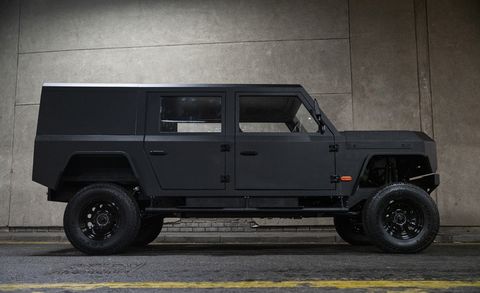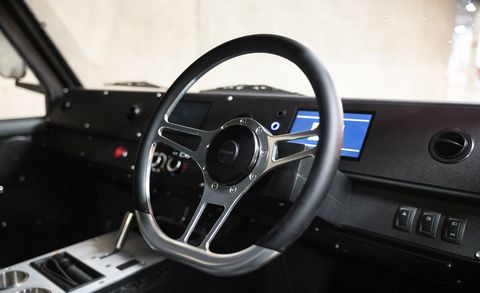Munro EV Looks Like Tesla Cybertruck and INEOS Grenadier's Love Child

This brand-new EV-only SUV from the U.K. startup Munro combines mechanical four-wheel drive with electric power.It’s being offered with a choice of 295-hp and 375-hp motors and 61.0-kWh and 81.0-kWh battery packs. The new SUV, just called the “Mk1,” will be coming to the U.S. in a limited run during 2023.
Neither the Tesla Cybertruck nor the INEOS Grenadier has come to market yet—but the Munro Mk1 may beat them to it, and it could pass as their love child. It’s an all-new fully electric SUV from Scotland that promises to combine a zero-emissions drivetrain with go-anywhere utility. The Scottish company building it confirms it will be sold in the States, with the first examples set to arrive here as soon as next year.
Car and Driver
Named after the term for a Scottish mountain more than 3000 feet in height, the Munro will be sold as a work truck rather than a leisure vehicle, although it is not hard to see its appeal to green adventurers. According to Munro CEO Russ Peterson, it has been designed to meet Class 3 medium-duty classification in the U.S., with either a two- or a five-seat cabin and the ability to carry up to 2200 pounds of cargo. It can also tow up to 7700 pounds under European testing methodology.
Beyond the electric powertrain, the Munro takes a very traditional approach. It sits on a ladder-frame steel chassis and uses solid axles at both ends, powered by a permanent four-wheel-drive system which incorporates a low-range transfer case intended for off-roading. A locking center differential will be standard, with locking front and rear diffs an option.

Car and Driver
Terrifyingly Quick?
While most electric SUVs use two or more motors, the Mk1 takes a much simpler approach. It uses a single centrally mounted axial flux motor which then supplies drive to each corner mechanically. Munro says it is planning to offer both 295-hp and 375-hp motor options, plus the choice of 61.0-kWh and 81.0-kWh battery capacities. (The packs are actually split into three, with one between the chassis rails and two more just outside.) The more powerful motor will only come with the bigger battery. Munro says it’s targeting 190 miles of range under the European WLTP test; that would probably fall to less than 170 miles in the U.S. We don’t have a range prediction for the smaller pack. The Mk1 will support both AC charging and DC fast-charging. It will be quick, too—possibly terrifyingly so, given a claimed 4.9-second zero-to-62-mph time for the most powerful version. Top speed will be limited to 80 mph.
The Mk1’s bodywork has been designed by Ross Compton, who formerly worked at Bollinger Motors. The quad light units at each side at the front are off-the-shelf units designed to be easily replaced; the charging ports sit just inside the left-hand unit. Bodywork is aluminum, although with wheel arches protected by bolt-on fiberglass cladding that is intended to be easily replaced in the event of damage. Similar logic has dictated all-flat glass, allowing users in remote areas to cut replacement windows if they are unable to find original parts. (Gordon Murray used the similar idea for his innovative OX concept.)

No-nonsense interior of the Munro Mk1.
Car and Driver
The Mk1’s interior is similarly utilitarian. The concept shown at the launch event in Edinburgh didn’t have carpeting or a headliner, although we’re told the production version will gain some kind of noise insulation. Although short on toys, the cabin has plenty of room for five full-size adult occupants, and this is definitely one EV that won’t be criticized for a lack of luggage space: the huge plywood-lined load compartment has been sized to accommodate a 47.2-by-31.5-inch pallet. There are also two storage lockers within the front fenders that can be accessed by small flaps on top; this arrangement is intended to help keep dirty items out of the cabin.
If Munro is able to deliver on its promises for the concept, the Mk1’s off-road performance should be impressive. The company claims a very impressive 18.9-inches of ground clearance and a 31.5-inch wading depth. Despite sitting on a 130-inch wheelbase, the Mk1’s minimal overhangs mean it is just 180.7 inches long, or 19.7-inches shorter than the new Land Rover Defender 130. The widely pushed axles also give the Mk1 a claimed 84-degree approach angle, 51-degree departure angle, and 31.6-degree ramp-over angle. We don’t have a finalized curb weight yet, but Munro is hoping this will be around 5500 pounds, which would be very impressive if delivered for such a sizable EV.
Having spent around £1m building the prototype, Munro is now raising funding that will allow it to started limited production of the Mk1, with early vehicles then sent to commercial users for in-the-wild testing. Beyond that the ambition is to create a new manufacturing facility capable of producing up to 2500 cars a year in Scotland – which would be the country’s first car factory since the former Chrysler plant at Linwood was closed in 1981. But Peterson also told C/D that any volume production for the U.S. would almost certainly come from a plant in North American to help avoid import taxes.
Pricing for the most basic two-seat version will be about $61,000 at current exchange rates and run to the equivalent of around $115,000 for the five-seater with the more powerful motor, bigger battery pack, and a full set of options including air suspension.
We look forward to finding out how it deals with the more rugged and remote parts of its homeland. Also, ours.
This content is imported from OpenWeb. You may be able to find the same content in another format, or you may be able to find more information, at their web site.



